Students must practice this TS Inter 1st Year Maths 1B Study Material Chapter 10 Applications of Derivatives Ex 10(b) to find a better approach to solving the problems.
TS Inter 1st Year Maths 1B Applications of Derivatives Solutions Exercise 10(b)
I.
Question 1.
Find the slope of the tangent to the curve y = 3x4 – 4x at x = 4. (V.S.A.Q.)
Answer:
Equation of the given curve is y = 3x4 – 4x
\(\frac{\mathrm{dy}}{\mathrm{dx}}\) = 12x3 – 4
Slope of the tangent at x = 4 is 12(4)3 – 4
= 12(64) – 4
= 764
Question 2.
Find the slope of the tangent to the curve y = \(\frac{x-1}{x-2}\) x ≠ 2 at x = 10. (V.S.A.Q.)
Answer:
Equation of the curve is y = \(\frac{x-1}{x-2}\)
= 1 + \(\frac{1}{x-2}\)
∴ \(\frac{d y}{d x}=-\frac{1}{(x-2)^2}\)
and slope of the tangent at x = 10 is
= \(-\frac{1}{(10-2)^2}=-\frac{1}{64}\)
Question 3.
Find the slope of the tangent to the curve y = x3 – x + 1 at the point whose x coordinate is ‘2’. (V.S.A.Q.)
Answer:
Equation of the curve is y = x3 – x + 1
∴ \(\frac{d y}{d x}\) = 3x2 – 1
Slope of the tangent at x = 2 is 3(2)2 – 1 = 11
Question 4.
Find the slope of the tangent to the curve y = x3 – 3x + 2 at the point whose x co-ordinate is ‘3’. (V.S.A.Q.)
Answer:
Equation of the curve is y = x3 – 3x + 2
\(\frac{\mathrm{dy}}{\mathrm{dx}}\) = 3x2 – 3
Slope of the tangent at x = 3 is 3 (3)2 – 3 = 24
![]()
Question 5.
Find the slope of the normal to the curve
x = a cos3θ, y = a sin3θ at θ = \(\frac{\pi}{4}\). (V.S.A.Q.)
Answer:
x = a cos3θ ⇒ \(\frac{d x}{d \theta}\) = 3a cos2θ (-sin θ) dθ
and y = a sin3θ ⇒ \(\frac{d y}{d \theta}\) = 3a sin2θ (cos θ)
\(\frac{\mathrm{dy}}{\mathrm{dx}}=\frac{\mathrm{dy}}{\mathrm{d} \theta} / \frac{\mathrm{dx}}{\mathrm{d} \theta}=\frac{3 \mathrm{a} \sin ^2 \theta \cos \theta}{-3 \mathrm{a} \cos ^2 \theta \sin \theta}\) = – tan θ
∴ Slope of the tangent at θ = \(\frac{\pi}{4}\) is – tan \(\frac{\pi}{4}\) = -1
and hence the slope of the normal = 1.
Question 6.
Find the slope of the normal to the curve x = 1 – a sin θ, y = b cos2θ at θ = \(\frac{\pi}{2}\). (V.S.A.Q.)
Answer:
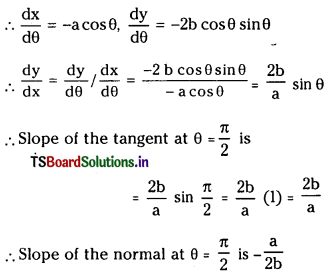
Question 7.
Find the points at which the tangent to the curve y = x3 – 3x2 – 9x + 7 Is parallel to the X-axis. (V.SA.Q.)
Answer:
Equation of the curve is y = x3 – 3x2 – 9x + 7
∴ \(\frac{d y}{d x}\) = 3x2 – 6x – 9
If the tangent is parallel to X – axis then
\(\frac{d y}{d x}\) = 0, ⇒ 3x2 – 6x – 9 = 0
⇒ x2 – 2x – 3 = 0
x = 3 or – 1
When x = 3, then
y = 33 – 3(3)2 – 9(3) + 7 = – 20
When x = – 1, then y = (- 1)3 – 3(- 1)2 – 9 = (-1) + 7 = 12
∴ The required points are (3, – 20), (-1, 12)
Question 8.
Find a point on the curve y = ( x – 2)2 at which the tangent is parallel to the chord joining the points (2,0) and (4, 4). (V.S.A.Q.)
Answer:
Equation of the curve is y = (x – 2)2
∴ \(\frac{d y}{d x}\) = 2(x – 2)
Slope of the chord joining points (2, 0) and (4, 4) is = \(\frac{4}{2}\) = 2
The tangent is parallel to the chord 2 (x – 2) = 2
⇒ 2x = 6
⇒ x = 3
y = (x – 2)2 = (3 – 2)2 = 1
The required point = (3, 1)
Question 9.
Find the point on the curve y = x3 – 11x + 5 at which the tangent is y = x – 11. (V.S.A.Q.)
Answer:
Equation of the curve isy = x3 – 11x + 5
∴ \(\frac{d y}{d x}\) = 3x2 – 11
The tangent is y = x – 11
Slope of the tangent is 3x2 -11 = 1
⇒ 3x2 = 12
⇒ x2 = 4
⇒ x = ± 2
y = x – 11, if x = 2 ⇒ y = – 9
The point on the curve is (2, – 9)
![]()
Question 10.
Find the equations of all lines having slope zero which are tangents to the curve y = \(\frac{1}{x^2-2 x+3}\) (V.S.A.Q)
Answer:
Equation of the given curve is y = \(\frac{1}{x^2-2 x+3}\)
∴ \(\frac{d y}{d x}=\frac{-1(2 x-2)}{\left(x^2-2 x+3\right)^2}\)
Given slope of the tangent is ‘O’ .
\(\frac{-2(x-1)}{\left(x^2-2 x+3\right)^2}\) = 0 ⇒ x = 1
At x = 1 ⇒ y = \(\frac{1}{1-2+3}=\frac{1}{2}\)
The point is (1, \(\frac{1}{2}\))
Slope of the tangent is ‘0’
∴ Equation of the tangent is
y – \(\frac{1}{2}\) = 0 (x – 1) ⇒ 2y – 1 = 0
II.
Question 1.
Find the equations of tangent and normal to the following curves at the points indicated against. (S.A.Q.)
(i) y = x4 – 6x3 + 13x2 – 10x + 5 at (0, 5)
Answer:
\(\frac{d y}{d x}\) = 4x3 – 18x2 + 26x – 10
At x = 0, slope of the tangent = – 10
∴ Equation of tangent is
y – 5 = – 10 (x – 0) = – 10x
⇒ 10x + y – 5 = 0
Slope of the normal = \(\frac{1}{10}\)
∴ Equation of normal is
y – 5 = \(\frac{1}{10}\)(x – 0) ⇒ 10y – 50 = x
⇒ x – 10y + 50 = 0
(ii) y = x3 at (1, 1)
Answer:
\(\frac{d y}{d x}\) = 3x2
At (1, 1), slope of the tangent = 3 (1)2 = 3
Equation of the tangent at P (1, 1) is
y – 1 = 3 (x – 1)
⇒ 3x – y – 2 = 0
Slope of the normal = –\(\frac{1}{3}\)
∴ Equation of the normal is
y – 1 = –\(\frac{1}{3}\)(x – 1)
⇒ 3y – 3 = -x + 1
⇒ x + 3y – 4 = 0
(iii) y = x2 at (0, 0)
Equation of the curve is y = x2
\(\frac{\mathrm{dy}}{\mathrm{dx}}\) = 2x
At (0, 0) the slope of the tangent is ‘O’ Equation of the tangent is y – 0 = 0 (x – 0)
⇒ y = o
Let equation of normal which is perpendicular to the tangent is of the form x = k
Since the normal passes through (0, 0) we have k = 0
∴ Equation of the normal is x = 0
(iv) x = cos t, y = sin t at t = \(\frac{\pi}{4}\)
Answer:
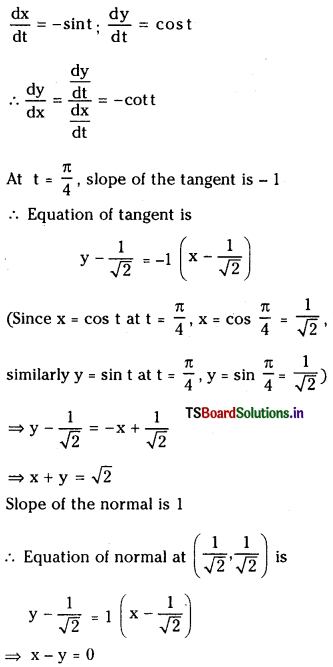
![]()
(v) y = x2 – 4x + 2 at (4, 2)
Answer:
Equation of the curve is y = x2 – 4x + 2
∴ \(\frac{d y}{d x}\) = 2x – 4
Slope of tangent at (4, 2) is 2(4) – 4 = 4
Equation of the tangent is y – 2 = 4(x – 4)
⇒ 4x – y – 14 = 0
Slope of the normal = \(\frac{-1}{4}\)
∴ Equation of the normal is
y – 2= \(\frac{-1}{4}\)(x – 4)
⇒ 4y – 8 = -x + 4
⇒ x + 4y – 12 = 0
(vi) y = \(\frac{1}{1+x^2}\) at (0, 1)
Answer:
Given equation of the curve is y = \(\frac{1}{1+x^2}\)
∴ \(\frac{d y}{d x}=\frac{-2 x}{\left(1+x^2\right)^2}\)
At (0, 1), slope of the tangent = 0
Equation of the tangent is y – 1 = 0 (x – 0)
⇒ y = 1
Slope of the normal = ∞
∴ Equation of the normal is
y – 1 = \(\frac{1}{0}\) (x – 0)
⇒ x = 0
Question 2.
Find the equations of tangent and normal to the curve xy = 10 at (2, 5). (S.A.Q.)
Answer:
Given equation of the curve is xy = 10
y = \(\frac{10}{x} \Rightarrow \frac{d y}{d x}=\frac{-10}{x^2}\)
Slope of the tangent at the point (2, 5) is \(-\frac{10}{4}=-\frac{5}{2}\)
Equation of the tangent is
y – 5 = \(-\frac{5}{2}\) (x-2)
2y – 10 = -5x + 10
⇒ 5x + 2y – 20 = 0
Slope of the normal is \(\frac{2}{5}\)
∴ Equation of normal at (2, 5) is
y – 5 = \(\frac{2}{5}\)(x – 2)
⇒ 5y – 25 = 2x – 4
⇒ 2x – 5y + 21 = 0
Question 3.
Find the equations of tangent and normal to the curve y = x3 + 4x2 at (-1, 3). (S.A.Q.) (May 2014)
Answer:
Equation of the curve is y = x3 + 4x2
∴ \(\frac{d y}{d x}\) = 3x2 + 8x
Slope of the tangent at (- 1, 3) is
= 3 (- 1)2 + 8 (- 1) = – 5
Equation of tangent at (- 1, 3) is
y – 3 = – 5 (x + 1)
⇒ 5x + y + 2 = 0
Slope of the normal at (- 1, 3) is \(\frac{1}{5}\)
∴ Equation of normal at (- 1, 3) is
y – 3 = \(\frac{1}{5}\)(x + 1)
⇒ 5y – 15 = x + 1
⇒ x – 5y + 16 = 0
![]()
Question 4.
If the slope of the tangent to the curve x2 – 2xy + 4y = 0 at a point on it is \(\frac{-3}{2}\), then find the equations of tangent and normal at that point. (S.A.Q.)
Answer:
Equation of the curve is
x2 – 2xy + 4y = 0
Differentiating with respect to x
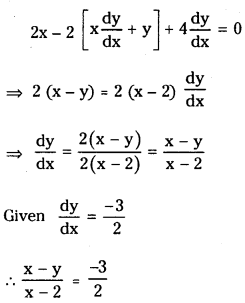
⇒ 2x – 2y = – 3x + 6
⇒ 5x – 2y – 6 = 0 (2)
⇒ 2y = 5x – 6
P (x, y) is a point on the curve and x2 – x (5x – 6) + 2 (5x – 6) = 0
⇒ x2 – 5x2 + 6x + 10x -12 = 0
⇒ -4x2 + 16x- 12 = 0
⇒ – 4 (x2 – 4x + 3) = 0
⇒ x2 – 4x + 3 = 0
⇒ (x – 1) (x – 3) = 0
Case – (i): x = 1, then form (1)
1 – 2y + 4y = 0 ⇒ 2y + 1 = 0 ⇒ y = –\(\frac{1}{2}\)
∴ Required point is P(1, –\(\frac{1}{2}\))
Equation of tangent is
y + \(\frac{1}{2}=\frac{-3}{2}\)(x – 1)
⇒ 2y + 1 = -3x + 3
⇒ 3x + 2y – 2 = 0
Equation of normal is
y + \(\frac{1}{2}=\frac{2}{3}\)(x – 1)
⇒ \(\frac{2 y+1}{2}=\frac{2}{3}\)(x – 1)
⇒ 6y + 3 = 4x – 4
⇒ 4x – 6y – 7 = 0
Case – (ii): When x = 3
∴ From (1); 9 – 6y + 4y = 0
⇒ y = \(\frac{9}{2}\)
Equation of the tangent is
y – \(\frac{9}{2}=\frac{-3}{2}\)(x – 33)
⇒ 2y – 9 = -3x + 9
⇒ 3x + 2y – 18 = 0
Equation of the normal is
y – \(\frac{9}{2}=\frac{2}{3}\)(x – 3)
⇒ \(\frac{2 y-9}{2}=\frac{2}{3}\)(x – 3)
⇒ 6y- 27 = 4x- 12
⇒ 4x – 6y + 15 = 0
Question 5.
If the slope of the tangent to the curve y = x log x at a point on it is \(\frac{3}{2}\), then find the equations of tangent and normal at that point. (S.A.Q.)
Answer:
Equation of the curve is y = x log x
\(\frac{\mathrm{dy}}{\mathrm{dx}}\) = x . \(\frac{1}{x}\) + log x = 1 + log x
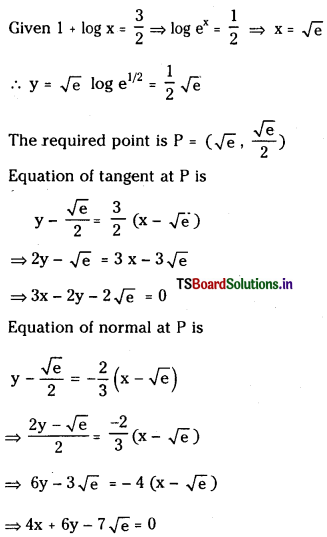
Question 6.
Find the tangent and normal to the curve y = 2e-x/3 at the point where the curve meets the Y-axis.
Answer:
Equation of the curve is y = 2e-x/3
Equation of Y – axis is x = 0 ⇒ y = 2
Required point = (0, 2)
Equation of tangent at P (0, 2) is
y – 2 = \(\frac{-2}{3}\)(x – 0)
⇒ 3y – 6 = – 2x
⇒ 2x + 3y – 6 = 0
Equation of the normal is
y – 2 = y(x – 0)
⇒ 2y – 4 = 3x
⇒ 3x – 2y + 4 = 0
III.
Question 1.
Show that the tangent at P(x1, y1) on the curve curved √x + √y = √a is yy1\(\frac{-1}{2}\) – 2 +xx1\(\frac{-1}{2}\) = a\(\frac{1}{2}\) (E.Q.) [June 2004]
Answer:
Equation of the curve is √x + √y = √a
Differentiating with respect to x,
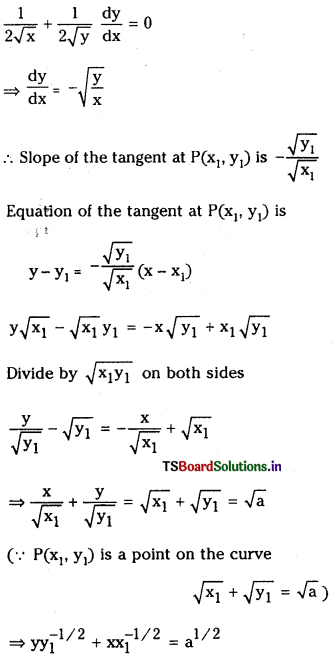
Question 2.
At what points on the curve x2 – y2 = 2, the slopes of the tangents are equal to 2 ?(E.Q.)
Answer:
Given equation of the curve
x2 – y2 = 2 ……….(1)
Differentiating with respect to ‘x’
2x – 2y\(\frac{d y}{d x}\) = 0
⇒ \(\frac{\mathrm{dy}}{\mathrm{dx}}=\frac{\mathrm{x}}{\mathrm{y}}\)
∴ Slope of the tangent at P(x1, y1) = 2
Also \(\frac{x_1}{y_1}\) = 2 ⇒ x1 = 2y1
Since P(x,, y,) is a point on the curve
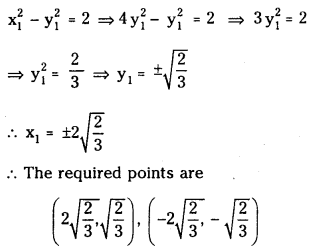
![]()
Question 3.
Show that the curves x2 + y2 = 2 and 3x2 + y2 = 4x have a common tangent at the point (1, 1). (E.Q.)
Answer:
Equations of the curves are
x2 + y2 = 2 ……….(1)
3x2 + y2 = 4x ……(2)
From (1) we have 2x + 2y \(\frac{d y}{d x}\) = 0
⇒ \(\frac{\mathrm{dy}}{\mathrm{dx}}=\frac{-x}{y}\)
Slope of the tangent to the curve (1) at (1, 1) is m1 = \(\frac{-1}{1}\) = -1
Also from (2), 6x + 2y = 4 dy
⇒ 2y\(\frac{d y}{d x}\) = 4 – 6x
⇒ \(\frac{d y}{d x}=\frac{4-6 x}{2 y}\)
Slope of the tangent to the curve (2) at (1, 1) is m2 = \(\frac{4-6}{2}=-\frac{2}{2}\) = -1
The slope of the tangents to both the curves at P(1, 1) are same and pass through the same point (1,1).
∴ The given curves have a common tangent at P(1, 1).
Question 4.
At a point (x1, y1) on the curve x3 + y3 = 3axy show that the tangent is (x12 – ay1)x + (y12 – ax1) y = ax1y1 (E.Q.)
Answer:
Equation of the curve is x3 + y3 = 3axy
Differentiating w.r. to ‘x’
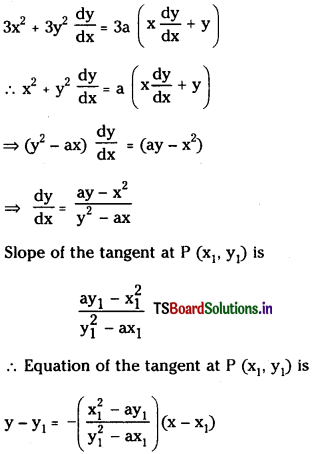
⇒ y (y12 – ax1) – y1(y12 – ax1) = -x(x12 – ay1) – x1(x12 – ay1)
⇒ x(x12 – ay1) + y(y12 – ax1) = -x(x12 – ay1) + x1(x12 – ay1)
⇒ x(x12 – ay1) +y1(y12 – ax1)
= x13 – ax1y1 + y13 – ax1y1
= x13 – ax1y1 + y13 – ax1y1
= x13 + y13 – 2ax1y1
= 3ax1y1 – 2ax1y1
= ax1y1
(∵ (x1, y1) is a point on the given curve and x13 + y13 = 3ax1y1)
Question 5.
Show that the tangent at the point P(2, – 2) on the curve y(1 – x) = x makes intercepts of equal length on the coordinate axes and the normal at P passes through the origin. (E.Q.)
Answer:
Given equation of the curve is y(1 – x) = x
⇒ y = \(\frac{x}{1-x}\)
∴ Differentiating w.r.t to ‘x’
\(\frac{d y}{d x}=\frac{(1-x)-x(-1)}{(1-x)^2}=\frac{1}{(1-x)^2}\)
At P(2, -2), slope of the tangent = \(\frac{1}{(1-2)^2}\) = 1
Equation of tangent at P(2, – 2) is
y + 2 = 1 (x – 2)
⇒ x – y = 4
⇒ \(\frac{x}{4}+\frac{y}{(-4)}\) = 1 (Intercepts form}
The tangent makes equal intercepts on the co-ordinate axes but they make intercepts with opposite sign.
Equation of normal at P is
y – y1 = – 1 (x – x1)
⇒ y + 2 = – 1(x – 2)
⇒ x + y = 0
This passes through the origin.
Question 6.
If the tangpnt at any point on the curve x2/3+ y2/3 – a2/3 intersects the co-ordinate axes in A and B, then show that the length AB is aconstant (E.Q.) [Mar.’14,T3, ’08, ’07, ’05]
Answer:
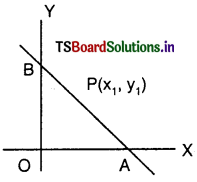
Equation of the curve is
x2/3+ y2/3 = a2/3 ……………..(1)
Differentiating w.r. to ‘x’
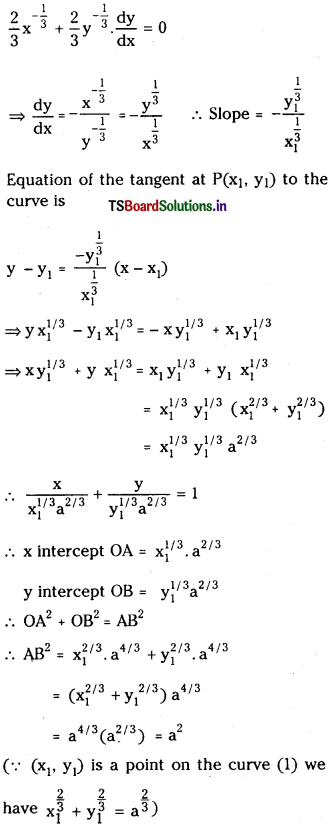
![]()
Question 7.
If the tangent at any point P on the curve xm y” = am+“ (mn 5* 0) meets the co-ordinate axes in A and B then show that AP : PB is a constant. (E.Q.)
Answer:
Given curve is xmyn = am+n, (mn ≠ 0)
Differentiating with respect to ’x’
xmnyn-1.\(\frac{d y}{d x}\) + yn. mxm-1 = 0
⇒ \(\frac{d y}{d x}=-\frac{y^n m x^{m-1}}{x^m n y^{n-1}}=-\frac{m}{n} \cdot \frac{y}{x}\)
Slope of the tangent at (x1, y1) = \(\frac{-\mathrm{my}_1}{\mathrm{nx}_1}\)
∴ Equation of the tangent at (x1, y1) is
y – y1 = nx1 (x – x1)
⇒ nx1y – nx1y1 = \(\frac{-m y_1}{n x_1}\)mxy1 + mx1y1
⇒ mxy1 + nx1y = (m + n) x1y1
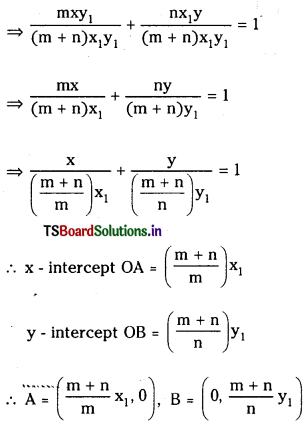
If P divides AB in the ratio m1 : m2 then co-ordinate of P are
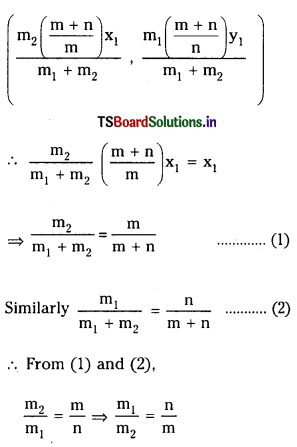
∴ Point P divides AB in the ratio n : m and AP : PB = n : m = a constant.